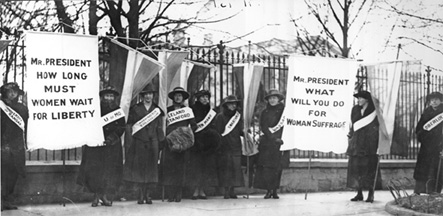
Bryn Mawr on the Picket Lines - The Radicals and Activists
In spite of the NAWSA's longstanding suffrage campaign, by 1912 only eight
states had adopted full voting rights for women, all in the sparsely populated
west. 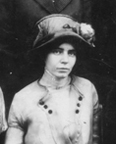 Its
failure to gain support in the eastern part of the country is partially
Its
failure to gain support in the eastern part of the country is partially 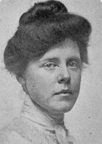 attributed
by some scholars to President Anna Howard Shaw's lack of political abilities.
Clearly the organization was ready for change and it came in the form of younger
members who were eager to apply more confrontational tactics than the more sedate
ones endorsed by the established leadership.
attributed
by some scholars to President Anna Howard Shaw's lack of political abilities.
Clearly the organization was ready for change and it came in the form of younger
members who were eager to apply more confrontational tactics than the more sedate
ones endorsed by the established leadership.
The new activists were lead by Alice Paul (Swarthmore College '05, University
of Pennsylvania, Ph.D., '12) and Lucy Burns (Vassar College '02) of the Congressional
Union (CU), a subcommittee of the NAWSA. Paul and Burns had spent time in England
during the WSPU's most radical phase and were greatly influenced by Pankhurst's
militant tactics. Both women had participated in protests and had held hunger
strikes in prison - experiences that they later taught to and shared with their
American colleagues.
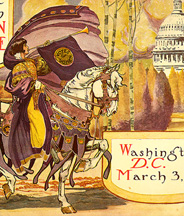 Alice
Paul, Lucy Burns and the Congressional Union organized the landmark March 3,
1913 parade in Washington, D.C. that preceded Woodrow Wilson's presidential
inauguration. The parade generated much attention but also drew a hostile crowd,
leading to a mob blocking the progress of the parade and confrontations with
police who failed to curtail the crowds of onlookers. The NAWSA leadership,
despite their participation in the event, disapproved of the CU's dramatic tactics
and disagreed strongly with the CU's uncompromising opposition to politicians
who did not actively promote woman suffrage. In 1914 Paul, Burns, and their
supporters were dismissed from the NAWSA.
Alice
Paul, Lucy Burns and the Congressional Union organized the landmark March 3,
1913 parade in Washington, D.C. that preceded Woodrow Wilson's presidential
inauguration. The parade generated much attention but also drew a hostile crowd,
leading to a mob blocking the progress of the parade and confrontations with
police who failed to curtail the crowds of onlookers. The NAWSA leadership,
despite their participation in the event, disapproved of the CU's dramatic tactics
and disagreed strongly with the CU's uncompromising opposition to politicians
who did not actively promote woman suffrage. In 1914 Paul, Burns, and their
supporters were dismissed from the NAWSA.
The direct and bold strategies of the NWP involved considerable agitation and personal risk on the part of its members. This style was attractive to a different and sometimes younger group of Bryn Mawr women, but it also appealed to alumnae dissatisfied with the NAWSA.
Bryn
Mawr College was well represented in the NWP's frequent picketing and marches
in Washington, D.C. The "Silent Sentinels" paraded in front of the
Capitol and the White House regardless of weather, police harassment, public
disregard, and after the country entered World War I, the very real possibility
threat of arrest and imprisonment. The White House picketing was often organized
thematically or by state. Saturday, February 3, 1917 was designated as "College
Day on the Picket Line." The occasion produced the only known photographs
of a Bryn Mawr picket. Thursday, January 24, 1917, was Pennsylvania's day; the
delegation included Ella Riegel '89.
Ella Reigel '89 (1866-1936)
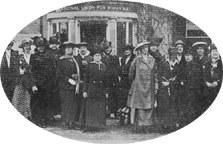 Ella
Riegel was a member of the National Finance Committee of the Congressional Union
and served as the business manager of two major campaigns organized by the Union.
She accompanied the April 1916 "Suffrage Special," a group of suffragists
who traveled by train to enlist the support of voting women in the western states,
and the February 1919 "Prison Special." Riegel was arrested in the
1918 picketing of the White House.
Ella
Riegel was a member of the National Finance Committee of the Congressional Union
and served as the business manager of two major campaigns organized by the Union.
She accompanied the April 1916 "Suffrage Special," a group of suffragists
who traveled by train to enlist the support of voting women in the western states,
and the February 1919 "Prison Special." Riegel was arrested in the
1918 picketing of the White House.
Mary Gertrude Fendall '12 (1889-1971)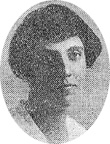
Mary Gertrude Fendall served as Chairman of Literature for the Congressional
Union, Treasurer of the Executive Committee of the National Woman's Party, and
as a NWP lobbyist and organizer. She was known in Washington as "the girl
who had managed the picket line . . . ."
Mary H. Ingham '03
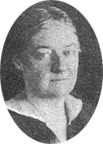 Mary
H. Ingham, Chairman of the Pennsylvania Branch of the NWP, was arrested three
times while picketing the White House. The Alumnae Quarterly of November
1917 reported that she had
Mary
H. Ingham, Chairman of the Pennsylvania Branch of the NWP, was arrested three
times while picketing the White House. The Alumnae Quarterly of November
1917 reported that she had
made the great sacrifice last summer of picketing the White House and of serving her term in the Occoquan Work-House, VA., for carrying a banner inscribed with a quotation from President Wilson. At a meeting at her house after her release from prison over $8000 was raised for the campaign of the National Woman's Party.
Mary Winsor '18 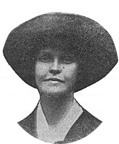
Mary Winsor became a pro-suffrage activist even before her graduation from Bryn
Mawr. She was arrested in the summer of 1917 and served a sixty-day term in
the Occoquan Workhouse, where she was denied warm clothing and prescribed medicines.
The experience seems not to have deterred her, however; the following summer
she was arrested again, along with her sister, Ellen. Winsor was released a
few days later after a hunger strike. In February 1919 she was in charge of
finance on the "Prison Special" campaign.
Pauline Clarke '12 (1887-1968)
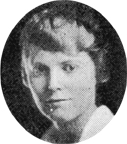 Pauline
Clarke '12, President of Bryn Mawr's chapter of the NCESL in her senior year,
was the co-editor of, and a reporter for, NWP's The Suffragist from March
1917 to February 1918. She and Mary Winsor '18 were arrested in the August 6,
1918 rally in Lafayette Park, opposite the White House. In her coverage of the
subsequent trial, Clarke reported:
Pauline
Clarke '12, President of Bryn Mawr's chapter of the NCESL in her senior year,
was the co-editor of, and a reporter for, NWP's The Suffragist from March
1917 to February 1918. She and Mary Winsor '18 were arrested in the August 6,
1918 rally in Lafayette Park, opposite the White House. In her coverage of the
subsequent trial, Clarke reported:
No lawyer defended the women, but they spoke in their own behalf, defending themselves on the ground of the constitutional right of free assemblage and appeal to the government for redress of grievances. In every case a plea of not guilty was entered, and many of the women added the statement that they did not recognize the jurisdiction of the court.
The Suffragist, August 24, 1918
Alice Henkle '05 (d. 1957)
Alice Henkle was "Captain of the Picket Line" at the United States Capitol in the spring of 1917 and an NAWSA organizer in Kansas City in 1918. She wrote of her picketing experiences:
And so they come and go-some wondering, a few deriding, the great mass helping and encouraging. We who stand holding those banners every day know that, once seen, men and women do not forget our purple, white and gold flags. They have come to symbolize our insistent demand for justice.
The Suffragist, May 12, 1917